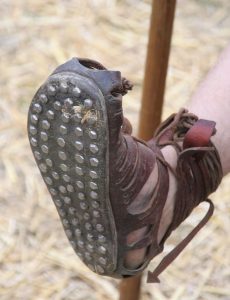In the Mishnah’s list of forbidden items (Shabbat 60) for a man on Shabbat is the סנדל מסומר, a nailed sandal. The Gemara explains that this type of sandal caused a panic resulting in death during the time of the שמד, religious persecution. It is unclear why that would result in the sandal being forbidden on Shabbat and both the Bavli and the Yerushalmi try to explain the issue.
What is a סנדל מסומר? It seems to be the same as another rabbinic footwear term, the קלגס. Both of them refer to a type of shoe worn by Roman soldiers called a caliga. This was a boot with vents and a thick sole studded with hobnails:
Our sources emphasize the nails: the impressions they make in the ground as well as their clattering sound:

No machine-readable author provided. MatthiasKabel assumed (based on copyright claims)., CC BY-SA 3.0 <http://creativecommons.org/licenses/by-sa/3.0/>, via Wikimedia Commons
Sandals like these, as well as the nails alone, were found at Masada and at other sites around Israel. At Masada, a pay slip for a Roman soldier was found, with the price of his caligae deducted from his salary!
What is the meaning of the Shabbat prohibition? Maybe there was a nationalistic reason, an attempt by the rabbis to ban footwear so clearly associated with the Roman army. But Professor Hanan Eshel adds an intriguing Shabbat element to the mix. It seems that the nails often were not in a random pattern but spelled out letters and even words. One such pair, found in Egypt have the nails arranged to spell out “after me!” In this case, wearing the sandals on Shabbat could lead to violating the prohibition against writing.
Further reading: H. Eshel, “סנדלים מסומרים במקורות היהודיים והממצא במערות המפלט” in מערות מפלט בתקופת מרד בר כוכבא.











